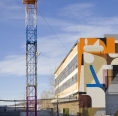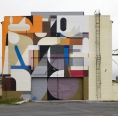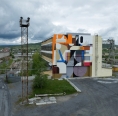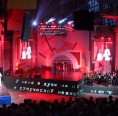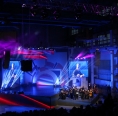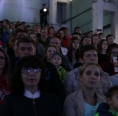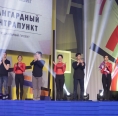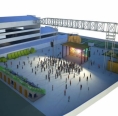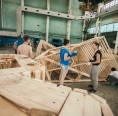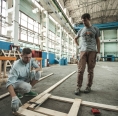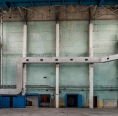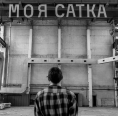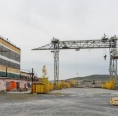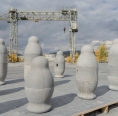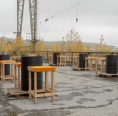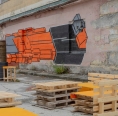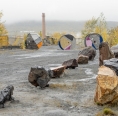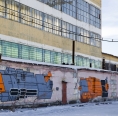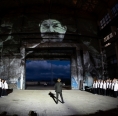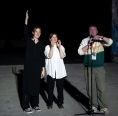-
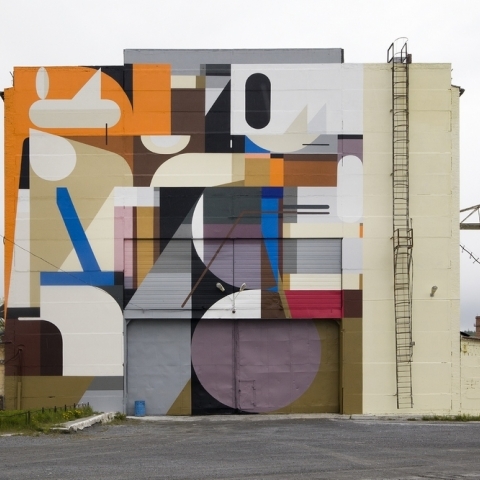
Hangar
The art space
The art space in the territory of former BelAZ repair shop is the large-scale project of Magnezit Group and the Sobranie Fund for city residents. Its main objective is global social education where new cultural experience becomes a driver of personal and urban development.
The conceptually new phenomenon for the Southern Urals was created by team of curators, designers and volunteers as a part of «My Satka» festival. The «Angar 18» project was presented on September 21 in the Magnezit museum.
A Part of Cultural Code
“Any exhibition, art project, art event gathers a community of people who care and are ready to devote their time and efforts to change the situation in place. Art, especially its modern forms, is a proactive force, an impulse for development of own creative processes. It gives a sense of presence of life, energy of place. We realized that culture can transform environment,” says the Sobranie Fund director Natalya Nikiforova.
A need has emerged to create a multifunctional platform for free creation and communication which will help to concentrate city’s cultural initiatives. The main idea of the project is to attract creative young people and to expand cultural horizons of local community which lacked artistic impressions for many years.
Former shop of Magnezit plant is a part of Satka’s history and cultural code. Located within city, it has a large territory and is a best place for the revitalization.
Experts developed the strategy of urban transformations in 2016. The Hangar was a part of the analytical project “The Catalysts of Urban Transformations” supported by the Swiss Arts Council Pro Helvetia, the Swiss Society of Engineers and Architects (SIA International), and the Swiss Center for Entrepreneurship involving consultants and architects from Germany. The project concept revealed the prospects of using and developing territory as a part of the main socio-cultural strategy of the district.
New Formats
In the past few years, the Hangar has become a notable event location of Satka. Since 2013, its walls host annual celebrations of the Metallurgist Day – from club format to modern performances and symphonic shows.
Energetic transformations started in autumn 2018. The first stage was transformation of the area surrounding the Hangar.
“We wanted to explore the potential of the site and to summarize all ideas for its development, and thus, in early August, we organized the project seminar “Hangar 18: Territory of Opportunities” attended by architects Dmitry Barudin, Mikhail Labazov,” says architectural curator of the festival, designer Egor Larichev. “In addition to the development concept, we drawn up next year’s plan of “shock” territory humanization measures as a part of 2018 festival”.
Very flexible space interpretation allowed to expand the potential of each site near the Hangar and to take into account all conditions necessary for full-value pastime: a parking lot, recreational areas, a platform for open-air events.
The huge painting on the facade by Alexey Luchko (Luka), a Russian artist who participated in the second international street art festival “Satka Street Art Fest” was the first step to visual transformation of the territory. The side facade of the Hangar was chosen for graffiti by another participant of the street art festival, Dutch artist ZEDZ. ZEDZ also offered several color solutions to mark the territory around the Hanger. Lighting tower at the building entrance, industrial reels which demarcate the open-air events site, former Oxygen Booth which now became mobile street art gallery – all this is already turned into art objects according to ZEDZ’s project.
Composition «Two Spirits» by Swiss sculptor Florian Graf, a participant of 4th Industrial Biennale in Yekaterinburg, also took place among the art objects of the territory. The matreshka-shaped sculptures of refractory concrete were made in the Innovative Products Department of Magnezit Group. The recreation area is supplement with the Rock Garden, materials for which were picked by experts in Satka surroundings.
Another event, «Pere-Satka», was held during the architectural marathon. Led by Vera Viktorovna Merker, director of the ChelSU botanic garden, a group of dendrologists and volunteers planted cherry-trees, apple-trees and rowan-trees that will become a part of “green navigation” within the Hangar territory.
Ideas of the first stage of the “space of new meanings” development were implemented in 18 days due to efforts of curators, designers and volunteers. In spring, the cultural centre «Hangar 18» will start hosting educational and artistic projects created by city residents.
“We conceived the Hangar as a new culture territory to unite city activists and to form space for discussion and project activities, new formats and ideas. Such experience contributes to city dwellers’ motivation, increase of interest in participation in city life,” told the providers during the presentation. “By creating the Hangar, we want to form a common space for the nearby residents, for active city dwellers who come from other districts of the city, and for participants, experts, tourists from other cities.”
Photos by Sergey Poteryayev, Denis Shakirov, Alexey Luchko, Alexander Andrievich.
2016
Consortium of Swiss architects has presented the final solution of redevelopment of territories withdrawn from industrial use in Satka (Chelyabinsk Region). The project is implemented with support and direct involvement of Sobranie Fund and Magnezit Group pursuant to the agreement signed with the Consortium.
Let us remind you that the agreement of cooperation between Sobranie Cultural Initiative Supporting & Preservation Fund and the Consortium of Swiss Architects was signed as part of the project, Drivers of Urban Transformations. According to the document, architects Nicole Wirtz (Raumplanwirz GmbH), Tommy McInen (Helsinki Zürich) and Reto Ray (Nüssli AG) were to present their vision of the redevelopment of Satka territories of former or withdrawn from industrial use. These are Magnezit Group sites that are within the city boundaries and are to be removed from industrial use.
In the developed presentation of their project, Swiss experts have analysed competitive advantages of Satka, its geographical and geopolitical location, potential in terms of tourism development and improvement of quality of life of local residents.
As for Magnezit Group sites, here, according to the architects’ concept, it is necessary to deploy a large-scale cluster with the widest social and cultural tasks and opportunities for Satka residents and guests. This is a “live laboratory” dedicated to the three main fields: education, culture, leisure. According to the project, the laboratory is to house playgrounds for extreme sports, a hall for public events, parks, recreation areas etc. One of the project peculiarities is the option to transform the space depending on the task event providers face and number of people expected. “Being ready for changes is a matter of survival. Governments of the town and the region are well aware of that. Town development is not limited to its perimeter; quite obvious that it takes place in line with overall processes that today cannot be referred to as favourable. Nevertheless, if we don’t do anything now, we reject the long-term perspective. It’s very important to understand it, and here, as I see, there is consensus of all project participants – designers, top managers of Magnezit Group, municipal and regional authorities. And Satka residents, I hope”, — Elena Gonsales, architect, reviewer, curators of the II Moscow International Biennale, comments.
We’d like to add the financing is provided by Pro Helvetia Swiss Arts Council and Switzerland Global Enterprise, SIA International (Swiss Society of Engineers and Architects) with support of Sobranie Fund.
2023
July 17 will be the day of premiere of the audiovisual performance “Ledges”. This unique project in site-specific format is a collaboration of the community theater and modern theater experts. You can see how unusual this project is not only from its genre, but from the very idea of the performance, its realization, and the future venue. More on this in an interview with the project’s director and producer Ivan Minevtsev.
“Ivan, we saw the performance sketches created during Refractories Theater Laboratory not so long ago. Are you working on a new experiment in collaboration with Satka and Magnezit Group now?”
“Having been absorbed in the town’s and Magnezit’s life for quite some time, after making a theater laboratory, I understood that we don’t need anything usual or average. I mean, putting together a theater group, choosing a play, assigning roles, and making a stage performance with the locals – all this would not be interesting for the people of Satka or me. That’s why we decided to have an experimental project, completely groundbreaking, as avantgarde as Magnezit itself.
Satka is one of the few towns in our country that attracts artists and inspires creativity. Both the enterprise and the town are very open to art, including modern one. That’s why we decided to collaborate with the Satkinskiy District Development Assistance Fund, with support from Magnezit Group, to make quite an unusual gift for Metallurgist Day – an audiovisual performance based on a story of one of the Magnezit dynasties. And continuity of generations is very important both for the enterprise and for the town. These are not just empty words. Even we, working in Satka not for the first time, feel like we are a part of a big hard-working family.”
“Can you tell us now what dynasty you are talking about, what family history gave life to the performance?”
“Yes. It is about the Navolokin family, whose collective employment record is 820 years – what a crazy number! We’ve taken their story and used it as the foundation of our performance about people who, with their energy, power, their labor, talent and perseverance, work “in the field”, making products with their own hands. After speaking to the dynasty members, playwright Yekaterina Guzyoma wrote the song lyrics and monologues, composer Pavel Polyakov wrote music specifically for the project that will come to life thanks to his colleagues from Waldgang Art Group and will accompany the whole performance. They are responsible for the entire sound part of the performance. They are already working on it with local choirs.
We’ve gathered a choir of one hundred people, some of whom are actually related to the Navolokin family. Opera singer Tatiana Bikmukhametova will also take part in our performance, she is from this big family of Magnezitians too.
The choir is very important, because it is a powerful collective of people, like a big family, like an enterprise team, that works at a difficult, harsh production facility.”
“Your performance is audiovisual – what will the audience see and hear?”
“This is a very unconventional performance, very musical, choral, with interesting visuals. These are contributions by artist Varvara Ivanik, video artists Anton Slastnikov and Dmitry Ivanchenko. We have a lot of footage from the industrial site of Magnezit Group, we’ve filmed almost every one of the production processes. They are incredibly impressive! You, people from Magnezit, may be used to them, but for us these are unique phenomena, especially the mine, Karagay quarry. We will show the plasticity of some processes on stage, choreographer Natalia Shurganova is working on it. This way the production will become integral to the performance. The giant iron wall in Hangar – former garage for BelAZ trucks – will become a screen onto which we will project the video.
Finally, all parts of the performance will be joined together in a musical and visual action. Of course, the performance is not a light experience, just like the labor of factory workers, but I assure you, it is fantastic. We know what we do and we will amaze you.”
“Projects like this need to mature, and Satka has just the right “soil” for it: people of the district are already familiar with a variety of modern theater practices. And not only as spectators, but also as participants. What do you think created the conditions for “Ledges” to appear?”
“Magnezit Group’s systematic work with art. Both the enterprise and the town are filled with art in its most broad sense. It is everywhere: in landscaping, in very cool street art, in installations... It is great that you have chosen this path. And it is entirely logical that the new unique work of art is being created in Satka. We can’t really make judgments about it yet, but I’m sure that “Ledges” will be a one-of-a-kind project. Such performances are rare for Russia, if there even are any. And no one has ever made any like ours. No one has ever had a choir sing parts written specifically for a hundred people in the garage for BelAZ trucks (and not only in the garage!)”
“And is the Hangar’s acoustics suitable for your ideas?”
“Yes! Sounds fill it like a vessel! This place is absolutely not made for such projects, but this very thing is its value for a unique product. And when it sounds, when this quite strange place fills with the voices of townsfolk and the sounds of manufacturing processes, this will be an unforgettable experience for the audience.”
“What would you wish or recommend the audience and the participants before the premiere?”
“I think the audience needs to come and just relax. For an hour, they will be under a lot of “pressure” – musical, visual, emotional. And you should not fight this “pressure”. The performance itself is hard labor too, after which we will open the doors and let in some air. So, in the end, we will reach happiness and we will start breathing differently, as the air around us will be different.
This is a story about hearth and home, about feelings we have when we are with family. Returning to our family after work, we switch to a very light, kind, fresh emotion – to clear voice. You will understand what I’m talking about when you hear the final song performed by Tatiana Bikmukhametova. With her clear voice, like a string, she will somewhat draw a line at the 50th minute of the laborious journey we, the participants and the audience, will go and live through together, finally receiving good new experience, developing new neural pathways.
And my wish to the participants before they start: keep calm and enjoy choral singing, which should be really pleasurable, especially in such an unusual space and with such acoustic and visual dynamics we will create. I myself dream of going to the stage and singing together with the performance team, for everyone to experience this unreal feeling of unity with each other that choir gives. Because you become closer with a person when you are singing side by side. This is too an effect of big family. Singing is immensely important in Russian families and Russian art. When we sing with our entire family, in a choir, it is a mesmerizing feeling.”
“And my last question: is the title of the performance motivated by the “graphics” of Karagay quarry near the Hangar?”
“Yes. Ledges are the quarry itself. Its magnitude, power, and depth are man-made. Every ledge shows human labor, time required to create something important. The quarry is like a time spiral, its ledges are fragments of life and work of every member of the big family of Magnezit.”
Authors of the performance: director Ivan Minevtsev, designer Varvara Ivanik, composer and performers Pavel Polyakov and Waldgang Art Group, video artists Anton Slastnikov and Dmitry Ivanchenko, choreographer Natalia Shurganova, playwright Yekaterina Guzyoma.
Participants of the project: members of the Navolokin dynasty, workers and veterans of Satka Production Site of Magnezit Group, choir teams of the district and participants of Refractories Theater Laboratory.
Admission is by invitation, transfer will be provided for the guests.
2023
Audiovisual performance “Ledges” premiered on July 17 was an impression, a wonder, and even a shock. Angar Art Space (former garage of BelAZ trucks) was chosen as the place to show the innovative theatrical project created by the Theater of City Residents directed by Ivan Minevtsev.
On the eve of the show, we have already told the story of the unusual modern theatrical art project as viewed by a professional. Today we will try to show it as perceived by the spectators and participants.
The premiere was deliberately scheduled for a late evening. Just when it got dark, the spectators took their seats, the garage lights went down, and the acting space was opened. On the left, a part of a huge “box” made of concrete and iron was lit up with the blue night, which was to set in, faintly gleaming into the windows; on the right, the dusk lights faded away. In the center, a wall with sliding doors, which were used as a massive mechanical stage curtain, turned into a big cinema screen.
“The story we are going to tell you lasts for almost one hundred years. It is a story of one labor dynasty. The text, you will hear, is a playwriter’s fancy. The facts mentioned in the text are real. All the characters are not fictional, coincidences are not accidental”. This text, which appeared on the screen in parts on the background of quarry ledges and shrilly dribbling metal sounds, started the action. It was clear from the very beginning — the spectators will face somewhat incredible.
All the sounds and visuals in this performance became one of the main effects and served as a hyperbole, making the memories of the workers from Magnezit even more expressive and the parts of the mechanisms and rocks enlarged to а great extent almost tangible. The “full-immersion effect” was reached. Video frames continued changing on the screen; and after the inscription “Episode 1. Efim Kuzmich. 1874”, a soft and calm male voice said, as if it was a gramophone record:
“We dwelt in the suburbs of Ryazan. Maksimovka Village, Sapozhkovskiy District. We had a house. How can such a big family be without a house? Six children! We had a small land plot to grow food. And a horse. That was the reason to decide that we had cattle, therefore we were prosperous, and we were to be deprived of our possessions as kulaks. We did not really manage to pack our staff. Some documents only, and a couple of things. We just grabbed our children and took a train. When you have no idea where you go, it is the longest road. I saw the nature changing. It became such a … as if it occupied more space and became greater. I just heard the driver's voice: “Satka! Get off”… That was the place, where our family had to start from scratch. We lived in a barrack hut consisting of two rooms. There were no walls there, only fabric partitions instead of them. Few meters were to accommodate ten people. It was hard in the beginning. Children, a new place, and no possessions at all. I thought that time: there were two ways for me – to live in hatred for the things done to my family or to forget it and start the new life. I chose working at a plant. My son Nikifor joined me. We both worked as furnace chargers… So we started little by little”.
The story of Efim Navolokin, who arrived into Satka in the middle of the past century, was continued by his descendants (today the total length of service of this dynasty is more than 800 years). We could only hear the voice of Efim Kuzmich, but managed to see his son Nikifor – modern technologies revived his photo on the screen. As a result, were were told the story of six generations in one family. It involved not only storytellers and spectators, but also the choir — one of the main characters in the performance.
It appeared in the beginning of the second episode. When the sounds from production workshops and the music, which was written specially for the performance and played by art band “Waldgang” gradually drew louder, the curtains revealed a big singing group. Their snowy blouses and shirts seemed to cut up the suppressing dark space. The singers accompanied all the following episodes. The choir assembled all seemingly scattered sounds: workshop noises (ringing and groaning metal, shrieks, rattle, etc.), melodies and sound effects produced by musical instruments (Angar itself became a musical instrument, hitting it with iron elements was the dominant of the episode involving the male part of the choir), singing and talking voices, applause, and even whisper in the hall. The choir was the main “pin” of the performance.
In the final scene, opera singer Tatiana Bikmukhametova — a representative of the Navolokiny dynasty — joined the singers. At first her amazing voice “flew over” the hall: the young woman appeared behind the stands on a “balcony”, which was a former grounding area for a travelling crane. And then she effectively appeared before the audience walking down a bright white road caught by a searchlight and singing an aria in German about the most important things for every family: home and happiness.
A video of the performance can be viewed at the link.
-
2025
Lecture series on art
-
2012
The Russian Museum. Satka
-
2019
MAMM

